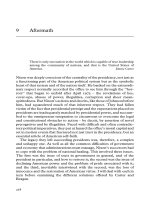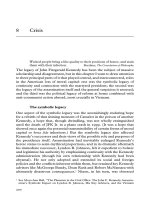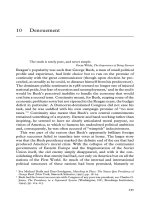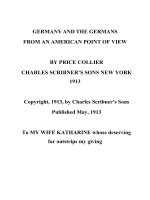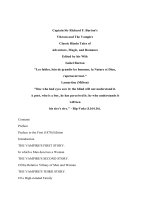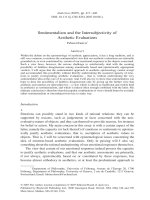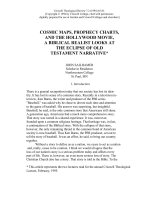Silent Film and the Triumph of the American Myth
Bạn đang xem bản rút gọn của tài liệu. Xem và tải ngay bản đầy đủ của tài liệu tại đây (16.4 MB, 235 trang )
Silent Film
and the
Triumph
of the
American MythPaula
Marantz
Cohen
OXPORD
UNIVERSITY
PRESS
2001
SILENT FILM
THE TRIUMPH OF THE
AMERICAN MYTH
OXFORD
UNIVERSITY PRESS
Oxford
New
York
Athens
Auckland Bangkok Bogota Buenos Aires Calcutta
Cape Town Chennai
Dar es
Salaam Delhi Florence
Hong
Kong Istanbul
Karachi Kuala Lumpur Madrid Melbourne Mexico City Mumbai
Nairobi
Paris
Sao
Paulo
Shanghai
Singapore
Taipei
Tokyo
Toronto
Warsaw
and
associated companies
in
Berlin
Ibadan
Copyright
©
2001
by
Oxford
University
Press
Published
by
Oxford University Press, Inc.
198
Madison Avenue,
New
York,
New
York 10016
Oxford
is a
registered trademark
of
Oxford University Press
All
rights reserved.
No
part
of
this publication
may be
reproduced,
stored
in a
retrieval system,
or
transmitted,
in any
form
or by any
means,
electronic,
mechanical, photocopying, recording,
or
otherwise,
without
the
prior permission
of
Oxford University Press.
Library
of
Congress Cataloging-in-Publication Data
Cohen, Paula Marantz,
1953-
Silent
film and the
triumph
of
the
American myth
/
Paula Marantz Cohen.
p. cm.
Includes index.
ISBN
0-19-514093-1,
ISBN
o-19-514O94-X
(pbk.)
1.
Silent
films—United
States—History
and
criticism.
I.
Title.
PNi995-75
.
M
37 2001
79
I.
43'o973-
dc21
00-033655
Frontispiece:
Conventionally,
the
last shot
of
Edwin
S.
Porter's
The
Great
Train
Robbery,
1903
(Museum
of
Modern Art).
135798642
Printed
in the
United States
of
America
on
acid-free
paper
In
memory
of
my
mother
Ruth Marantz Cohen
This page intentionally left blank
ACKNOWLEDGMENTS
A
NUMBER
OF
PEOPLE
were indispensible
to me in
writing this book.
My
colleague Dave
Jones
has
been
an
intellectual mentor
for
close
to
twenty
years.
A
superb critic
and
editor,
as
well
as a filmmaker
himself,
he
talked
to me
about initial ideas, read early
drafts,
and
refused
to let me get
away
with anything dishonest
or
imprecise.
His
insistence
on
clarity
and his
playful,
insightful
mind have made this
a
better book.
My
sister, Rosetta Marantz
Cohen,
and my
brother-in-law, Samuel Scheer,
read
the
book
at a
crucial juncture, when
I had
lost patience with
it, and of-
fered
encouragement
and
guidance. Theirs
are the
most discerning literary
sensibilities
I
know,
and I was
aided
by the
sharpness
of
their observations,
de-
livered
in
complementary vocabularies.
I owe an
immeasurable
debt
of
gratitude
and
love
to my
husband, Alan
S.
Penziner,
whose compendious knowledge
of
Western culture never ceases
to
amaze
me. He was the one who first
introduced
me to
silent movies
and
con-
vinced
me to
take them seriously.
As a
teenager,
he
used
to
make weekly visits
to
the New
School
for
Social Research
for
screenings
and
discussion
by the
great
film
lover
and
historian William
K.
Everson.
The
silent
film
library that
he
gathered
at
that
time,
long
before
I
knew him, uncannily anticipated
the
needs
of
this book.
I can
repay
him in one way at
least:
I can now sit
through
a
silent double
feature
with pleasure.
I
have
finally
become,
as he
says,
his
per-
fect
date.
I am
also
grateful
to
Miles Orvell
for
reviewing parts
of the
manuscript
with
the eye of a
seasoned Americanist; Mark Greenberg
for his
supportive
role
as a
friend
and
dean;
Rosemary
Abbate
for her
insights into performance
(I
am
convinced
she
would have made
a
great silent star);
my
research
assis-
tant, Brady Hammond,
for his
intelligence
and
competence;
and the
Drexel
University
students
in my
silent
film and
American literature courses whose
fresh
eyes
and
open minds helped
me to
think
in new
ways.
I
also want
to
thank
my
editor, Elissa Morris,
and her
assistant, Karen Leibowitz,
at
Oxford
viii
ACKNOWLEDGMENTS
University
Press;
the
reviewers
of the
manuscript
for
Oxford, whose comments
I
found
to be
uniformly
helpful;
Frank Nesko
of
Movies Unlimited,
the
rare
video store that respects
film
history;
the
librarians
in the
Theater Archive
at
the
Philadelphia
Public
Library;
and
Terry
Geesken
and
Mary Corliss
at the
Film
Stills
Archive
of the
Museum
of
Modern Art.
A final
thank
you
goes
to my
beloved
parents—my
father,
Murray
S. Co-
hen,
and my
late mother, Ruth Marantz
Cohen—who
taught
me how to
think
and
raised
me to
love ideas.
Parts
of
chapters
3 and 4 first
appeared
in the
literary journal
Boulevard.
CONTENTS
Introduction
3
1
Literary Antecedents
of
American Silent Film
21
2
Houdini, Keaton,
and the
Rise
of the
Body
43
3
Hart, Fairbanks,
and the
Vitalization
of
Landscape
71
4
Griffith,
Gish,
and the
Narrative
of the
Face
107
5
The
Birth
of the
Star System
and the
Shaping
of the
Modern
Self
131
6
The
Transition
to
Sound
161
Epilogue
177
Notes
183
Bibliography
201
Index
211
This page intentionally left blank
Silent Film
and the
Triumph
of the
American Myth
We've gone beyond Babel, beyond words.
We've
found a
universal
language—
a
power that
can
make
men
brothers
and
end war
forever.
Remember that.
Remember that, when
you
stand
in
front
of
the
camera.
D. W.
Griffith
to
Lillian Gish
INTRODUCTION
T
HE
PHOTOGRAPH,
taken
in
England
in the
early
1920s,
shows
two
cou-
ples:
Lord
and
Lady Mountbatten (right), members
of the
British royal
family,
and
Douglas Fairbanks
and
Mary Pickford
(left),
American movie
stars.
1
The
four
figures
have arranged themselves
in a
stunt pose
for the
cam-
era. Both women
are
perched
on the
right shoulders
of the
men;
the men
have
their
left
legs
and
left
arms raised
as if to
dramatize
the
ease with which they
hold
the
women
aloft.
The
photo relays
a
sense
of
communal fun,
yet a
close
examination shows some telling details. Mountbatten's
face
is
taut with con-
centration,
and he is
holding Fairbanks's hand
for
balance. Lady Mountbatten
is
similarly uneasy
and is
grasping
Pickford's shoulder.
What
is
clear
is
that Fairbanks
and
Pickford—Doug
and
Mary,
as
they were
then
known
to the
world—occupy
the
dominant position
in the
photograph.
Doug
is the
fulcrum
of the
group,
the
base
on
which
the
whole precarious
structure rests. Mary looks perfectly
at
home
on his
shoulder;
it is a
position
she
had
occupied
many
times
before. Whereas
the
British couple
appear
washed
out in
their pale
outfits,
the
Americans seem vibrant
and
alive—their
mix of
dark
and
light clothes
perfectly
in
tune with
the
camera's black-and-white
world.
The
effect
is
heightened
by
Fairbanks's
deep
suntan
and the
casual
stylishness
of his
sports jacket,
in
contrast
to
Mountbatten's stodgy double-
breasted suit.
But
what
is
most striking about
the
Americans
are
their
smiles—broad
and
relaxed, displaying
a
confidence missing
in
their hosts. Smiling
for the
camera
was,
of
course,
the
movie star's stock-in-trade,
but
there were also excellent rea-
sons
for
these stars
to
smile
at the time
this photograph
was
taken.
They
had
only
just married, having shed their original spouses
to
hardly
a
murmur
of
public
protest; they were both
near
the
peak
of
their careers, beloved
by
audi-
ences
as far
away
as
Russia
and
Japan;
and
they
had
recently formed with
D.
W.
Griffith
and
their best friend,
Charlie
Chaplin,
a new
movie company,
United Artists, destined
to
make them even
richer
than they already were.
The
couple was, quite simply,
the
envy
of the
world—why
else would British nobil-
ity
be
trying
so
hard
to
imitate them?
The
photograph
may
seem like
a
trifle—the
record
of one
moment
of
fun
in the
lives
of
four
famous
people—but
it is
more than that.
It is a
tribute
to the
burgeoning power
of a new
form
of
representation,
the
moving picture,
to
ele-
vate
its
favorites
and
delegate others
to the
background.
No
matter that
Preceding
page:
Douglas Fairbanks
and
Mary
Pickford
with Lord
and
Lady
Mountbatten (Broadlands Archives)
INTRODUCTION
Mountbatten's
family
could
be
traced back
to
Charlemagne
and
that
his
wife
was
the
granddaughter
of the
richest
man in
England. Fairbanks
and
Pickford
seem
the
more significant
figures.
They
dominate
the
photograph
because
their movies gave their looks
a
context that they carried with them wherever
they went. Doug's suntan
and
sports clothes
and
Mary's cherubic smile
and
game pose were
all
components
of an
American relationship
to
experience
that
had
been projected
on the
screen
and
become part
of a
universally shared
visual
language.
It is a
language
we
still
understand today;
for
whether
or not
we
recognize Doug
and
Mary
in the
photograph,
we
know,
based
on the
cues
of
their appearance,
that
they
are
"stars."
To see the
English aristocrats made pasty seconds
to the
American movie
stars
is to see a
graphic
enactment
of the
shift
in
power
from
Europe
to
Amer-
ica
that
was
occurring
in the first
three decades
of the
twentieth century. Doug-
las
Fairbanks
and
Mary
Pickford
were
the
distilled representatives
of
that
power.
They
were
the
purveyors
of a
uniquely American
conception
of
charac-
ter,
shaped
and
disseminated through
film,
that would, with apparent ease
and
in the
most genial spirit imaginable, usurp hereditary privilege
in its own
back-
yard.
How
did the
medium
of
silent
film
produce
a
Douglas Fairbanks
and a
Mary
Pickford?
How did
celluloid characters like these promote
the
idea
of the
self-
made American
and
elevate
it
above that
of the
European aristocrat? How,
in
short,
did the
movies help bring about
the
triumph
of a new set of
values
and
goals associated with American ascendancy
in the
twentieth century?
To
answer these questions,
one
needs
to
answer
a
number
of
related ones.
First,
how did
America
forge a
connection
to the
movies that would
be
more
powerful
than that
of any
other country? Second,
how did the
movies consoli-
date imagery associated with America
in a
compelling
way?
And
third,
how
did
this consolidation produce
an
image that could serve
as a
model
for all
Americans
and
become
the
prototype,
the
world over,
for a
modern kind
of
self?
I
will
try to
answer these questions
in the
following
chapters,
but I
begin
here
by
laying
the
groundwork
for the
relationship between
film and
America
as
it
would take shape
during
the
silent era.
Although many countries contributed
to the
development
of film
technology
and
production
at the
beginning
of the
twentieth century,
the
United States
had
emerged
as the
unrivaled center
of
world
filmmaking by
1920.
Several
fac-
tors
help account
for
this.
There
was the
influx
of
ambitious immigrants
to
American cities
in the
i88os
and
iSgos
that lent muscle
and
imagination
to a
5
INTRODUCTION
primitive
industry.
There
were
the
unrestricted economic conditions
of
turn-of-
the-century
America that allowed
for the
proliferation
of the first
store-front
movie
theaters—or
nickelodeons—that
generated
a
continual demand
for new
films.
There
was the
extraordinary resource
of
California, with
its
cheap real
estate
and fine
weather, where
the
American
film
industry
had the
good
sense
to
move
in the
mid-teens.
And
there
was the
reduction
of
foreign competition
as
World
War I
devastated
Europe, giving American
film an
advantage
that
it
would never lose. None
of
these
factors,
however, explains
the
profound sym-
biosis
that
has
existed between America
and the
movies
from
the first
decades
of
the
twentieth century
onward.
2
The
alliance between
film and
America
was the
result
of
more than eco-
nomic opportunity
and
available human
and
natural resources, though
it
drew
on
these
factors
for
support.
It
rested
on film's
ability
to
participate
in the
myth
of
America
as it was
elaborated
in the
course
of the
nineteenth century.
The
groundwork
for the
myth
had
been laid very early
in the
history
of the
nation
in
such works
as
St.
John
de
Crevecoeur's
Letters
from
an
American
Farmer
and
Thomas
Jefferson's
Notes
on the
State
of
Virginia.
The
authors
of
these works
were
men
with cultural
ties to
Europe
who had
cast their
lot
with America.
They
described their
new
country
as a
world
in the
process
of
being
born—at
once limited
in
having
no
conventionally agreed-upon past
to
draw
on
for
guid-
ance
and
advantaged
in
being
free
to
create
a
future
unhindered
by the
past.
By
the
18205,
their ideas
had
crystallized into
a
philosophical
self-conception—
a
national myth. "Unlike
the
Roman myth," explains
the
cultural historian
R. W. B.
Lewis, "which envisaged
life
within
a
long, dense corridor
of
mean-
ingful
history—the
American myth
saw
life
and
history
as
just beginning.
It
described
the
world
as
starting
up
again under
fresh
initiative,
in a
divinely
granted
second chance
for the
human race,
after
the first
chance
had
been
so
disastrously fumbled
in the
darkening
Old
World."
3
Alexis
de
Tocqueville,
who
visited
the
United States
in the
18305,
con-
nected
the
American myth
to the
kind
of art he
predicted
the
country would
produce. "Among
a
democratic people,"
he
wrote, "poetry
will
not be fed
with
legends
or the
memorials
of old
traditions.
. . . The
destinies
of
mankind,
man
himself
taken aloof
from
his
country
and his age and
standing
in the
presence
of
Nature
and of
God, with
his
passions,
his
doubts,
his
rare prosperities
and in-
conceivable wretchedness,
will
become
the
chief,
if not the
sole, theme
of po-
etry among these
nations."
4
Tocqueville's
notion
of a
country stripped
to its es-
sential components
and of an art
built
directly
from
them would
be
echoed
by
the first
great
American poet, Walt Whitman, when
he
called
for a new
kind
of
cultural expression
proper
to the
form
of
American
life.
6
INTRODUCTION
Film
appeared
at the
opportune
moment
and
with
the
properties neces-
sary
to
meet that call. Like America,
the
medium
was
seen
at its
origins
as
primitive
and
naive.
In any
discussion
of
early
film, the first
examples given
are
of
unmediated
slices
of
life:
people kissing, trains arriving, boxers throwing
punches.
The
ordinary subject matter
and
seemingly random documentary
techniques
of
early
film
made
it an
object
of
contempt
to a
cultured audience,
who saw it as the
entertainment
of the
riffraff,
destined
to
remain
on the
pro-
grams
of
vaudeville houses
and
burlesque halls.
Up
through
the
19503,
the
question
of
whether
film was an art at all
continued
to be a
valid
subject
for de-
bate,
and
much
of the
impetus behind early
formalist
and
esthetic
filmmaking
was
presented
in
terms
of the
medium's need
to
lift
itself
from
its
crude begin-
nings
and
overcome
its raw
material
("a
film
is not
shot,
but
built,"
declared
V.
I.
Pudovkin,
who, with Sergei Eisenstein,
is
seen
as the
father
of film
formal-
ism
5
).
But
what
the
formalists
tried
to
overcome, others embraced
as a
unique
strength.
In
being "the only
art
that
exhibits
its raw
material,"
film
possessed,
according
to the
great proponent
of
realist cinema,
Siegfried
Kracauer,
the
unique ability
to
"excavate"
and
"redeem"
reality. Another German theorist
of
the
19205,
Walter
Benjamin,
argued that
it was
precisely
film's
distance
from
traditional,
"high"
art
that gave
it the
potential
to
reach
the
people
and
trans-
form
their relationship
to
established power
relations.
6
Benjamin
stressed
the
mechanical aspects
of film
that could revolutionize
perception
much
in the way
the
steam engine
and the
cotton
gin had
revolutionized production. Both Kra-
cauer
and
Benjamin
saw in
cinematic realism
the
opportunity
to
clear away
the
artifice
of
established culture that obscured
a
true
and
empowering vision
of re-
ality.
This
was
precisely what American poets
and
politicians,
from
Crevecoeur
and
Jefferson
through Whitman
and
Theodore Roosevelt,
had
conceived
to be
the
nation's mission
for
civilization
as a
whole.
The
connection between
film and
America
was not
lost
on
early critics.
"Our
soil
has no
Roman coin
or
buried altar
or
Buddhist tope," wrote
the
poet
Vachel
Lindsay
in
1915;
film, he
said, could stand
in
place
of
these things
as a
"new hieroglyphics" proper
to
America's democratic character.
"It is
natural
that when
a new art
appears
in the
world
it
should choose
a new
people which
has
had
hitherto
no
really personal art," pronounced
the
French critic
Elie
Faure
in
1920,
"especially when this
new art is
bound
up,
through
the
medium
of
human gesture, with
the
power,
definiteness,
and firmness of
action." French
film,
Faure maintained,
"is
only
a
bastard
form
of a
degenerate
theater,"
whereas
"the Americans
are
primitive
and at the
same
time
barbarous, which
accounts
for the
strength
and
vitality which they
infuse
into their
cinema."
7
7
INTRODUCTION
Film,
such statements suggest,
was
like America
itself:
strong
in its
limitations,
innovative
in its
artlessness.
Behind
this tendency
to
link America
and film was the
idea
of
authenticity—of
a
privileged relationship
to
reality—that
both
the
country
and
the
medium
were seen
to
share.
In the
mid-nineteenth century, photography
had
already emerged
as an
American medium
by
establishing
itself
as a
direct
conduit
to the
real,
offering,
as one
commentator
of the
period
put
it,
"the con-
crete representation
of
consummated
facts."
8
The
daguerreotype image
is
"in-
finitely
more
accurate
in its
representation than
any
painting
by
human hands"
and
achieves "identity
of
aspect with
the
thing represented," proclaimed Edgar
Allan
Poe in
1840.
In the
i86os,
the
eminent jurist Oliver Wendell Holmes,
whose
enthusiasm
for
photography
led him to
invent
a new
version
of the
view-
ing
device known
as the
stereoscope,
lauded
the
photographic
image
as a
kind
of
"cast,"
or
second skin,
for
reality.
He
called
for the
creation
of a
National
Li-
brary
of
Images, which could save
the
public money spent
on
traveling
to see
the
real
thing.
"Matter
in
large masses must always
be fixed and
dear;
form
is
cheap
and
transportable," Holmes
maintained—a
statement that
has the
pho-
tograph stand
to
reality much
as
paper currency stands
to
gold. Samuel Morse,
inventor
of the
telegraph
and
extensively involved with developing photo-
graphic technology
in
America, went even
further
in
erasing
the
distinction
be-
tween
reality
and
image, conceiving
of
photographs
as he did
aural record-
ings—not
as
"copies
of
nature
but
portions
of
nature
herself."
9
Contributing
to the
American enthusiasm
for
photography—and
subse-
quently
for
film—was
the new
position that
the
observer
was
encouraged
to oc-
cupy
with respect
to the
image. Photography
was
revolutionary
in
that
it re-
placed
the
hand with
the eye as the
instrument
of
representation.
In
doing
so, it
seemed
to
transfer
the
locus
of
power
from
the
creator
to the
observer.
10
This
shift
conformed
to the
democratic principles
on
which America
had
been
de-
fined
as
a
nation:
it
took
away
the
presumption
on the
part
of the
photographer
to
a
privileged role since
the
photograph
appeared
to
record simply what
was
there;
at the
same
time it
made everyone
a
critic
since observers could invoke
their
own
sense
of
reality
to
compare with
the
photographic
image (art photog-
raphy, which would take issue with
this
kind
of
thinking,
did not
emerge until
the end of the
century).
In the
case
of
portrait photography,
the
democratic
im-
pulse
was
taken
further
because
it
became possible
to
conceive
of the
portrait
as
the
work
not of the
photographer
but of the
subject
being photographed:
"The artist stands aside
and
lets
you
paint
yourself,"
Ralph Waldo Emerson
de-
clared.
"If you
have
an ill
head,
not he but
yourself
are
responsible."
11
It
seems
appropriate that
the two figures
most associated with American democracy
in
8
INTRODUCTION
the
nineteenth century, Abraham Lincoln
and
Walt Whitman, were both
en-
amored
of
photography
and had
themselves photographed extensively during
their
lifetimes.
With
the
advent
of
moving pictures, this democratic transfer
of
power
from
artist
to
spectator
was
radically
intensified.
Movement
was no
mere
ad-
dendum
or
seasoning
to
photographic realism;
it was a
catalytic agent, trans-
forming
the
very nature
of
realistic portrayal. Movement
on film
introduced
duration
to the
recorded event,
and
since
we
experience duration
in
real
time,
this seemed
to
bring
the
"pastness"
of the
thing imaged into
the
present. Film's
rendering
of
movement
also
made possible
a
multiplication
of
realistic
effects,
as
elements captured
in
photographs were
now
combined
and
their
effects
amplified—a
vivid example
of
what Herman Melville
had
described
as the
American thirst
for
"more reality than reality
itself
can
show." Film could also
register involuntary movement
and
movement captured unaware: sneezing,
crying,
the
behavior
of
children
and
animals—providing
access
to
experience
unavailable
to any
other
form
of
representation. Finally
and
most
important,
movement
on film
precipitated
the
development
of film
narrative, which made
possible
an
unprecedented involvement
of the
viewer with
character—an
in-
volvement that could hardly
be
achieved
in
photography
and
painting
and
that
was
more intimate than anything possible
in
theater.
As a
result,
the film
spec-
tator came
to
identify
with
the
events
on the
screen
and to
feel
like
a
vital par-
ticipant
in
what
was
being
portrayed.
12
Thus,
the
property
of
movement, central
to film,
added
another
layer
or
dimension
to
photographic
realism.
It
produced
the
sense that reality
was
being
not
only recorded
but
also enacted,
and it
solidified
and
deepened
the
spectator's role
as the
focus
and
determinant
of
meaning.
In the
context
of film's
intensively realistic, spectator-based esthetic,
we can
iso-
late
three elements that became
the raw
material
of film and
which also hap-
pened
to be
defining
characteristics
of the
American myth.
In
isolating these
elements,
it is
helpful
to
refer
back
to
Tocqueville
when
he
described America
in
counterpoint
to
Europe
as a
country stripped
of
history
and its
associations.
What,
then, remains? "Man
in the
presence
of
Nature
. . .
with
his
passions
.
"
(my
emphasis). What remains,
to
translate this statement into images,
are
the
body,
the
landscape,
and the
face,
moving dynamically
in
combination.
These elements
are at the
center
of any
discussion
of film as an
American lan-
guage. They
are the
building blocks
of the
American myth,
and
their interac-
tion
accounts
for the
emergence
of
American
film as the
dominant
form
of
rep-
resentation
in the
twentieth century.
9
INTRODUCTION
The
elements
of
body, landscape,
and
face
constitute,
on
some level, what
Emerson referred
to as the
"nouns"
of
nature—those
concrete
facts
of
experi-
ence that make
up our
fundamental sense
of
reality.
13
Psychoanalytic
film
the-
ory
has
suggested that
the
cinematic
representation
of
these elements causes
the
spectator
to
regress
to
earlier psychic states:
film's
representation
of the
body
evokes
a
sense
of
physical invulnerability
and
wholeness;
its
representation
of
space,
a
sense
of
superhuman power
and
control;
and its
representation
of the
face,
a
sense
of
emotional intimacy with
a
monumental parental
figure. In
each
case,
the
cinematic image
is
said
to
correspond
to a
fantasy
that
has its
origin
in
the
most primal stage
of our
development
as
sentient beings. Such claims,
which
may
sound outlandish
to
those
unfamiliar with psychoanalytic vocabu-
lary,
find
additional support
in
common sense. Even
the
simplest
and
most
un-
tutored
film
spectator
lives
in a
world
of
bodies,
landscapes,
and
faces
and
there-
fore
brings highly charged, personal associations
to
bear
on
their
images.
14
That
said,
it
must
be
added
that
the way in
which
we see
these elements
is
not
simply,
and not
even primarily,
a
matter
of our
private experience. Film's
appropriation
of
bodies, landscapes,
and
faces
was not the
unmediated render-
ing of
reality that might
be
supposed. Each element
had
already acquired
defi-
nite
meanings
in
American
life
through association with other
forms
of
repre-
sentation.
The
body
had
been
showcased
in
burlesque
and
vaudeville;
the
landscape,
in
landscape painting
and
moving panoramas;
the
face,
in
photo-
graphic
portraits
and the
histrionic
forms of
theatrical acting favored
in
"low-
brow" theaters. Each,
in
short,
had
derived
a set of
meanings
by
being given
wide circulation through mostly popular, American
forms
of
cultural expres-
sion.
Film took these already coded elements
and
combined them, represent-
ing a
world that retained much
of the
vitality, coarseness,
and
democratic
ap-
peal
of the
expressive
forms
in
which they
had
been showcased individually.
And
this continued
to be
true even
after
film had
incorporated many highly
ar-
tificial
techniques
and had
moved
to
plush movie palaces designed
to
attract
more moneyed
and
sophisticated patrons.
A
good deal
of
effort
has
gone into
trying
to
explain
how
American
film
evolved
from
a
lower-class
to a
middle-
class
diversion
but
less
into
how it
managed
to
retain
its
lower-class audience.
The
answer lies
in
part
in the way film's
ability
to
seem real grew
out of
ele-
ments associated with lower-class,
specifically
American
forms of
entertain-
ment;
the
elements then continued
to be
marked
as
authentic through opposi-
tion
to
a
more
elitist,
"artful"
culture associated with Europe. This conceptual
link
to the
authenticity associated with popular culture also helps explain
why
American
film has
retained
its
opposition
to
European formalism,
despite
con-
tinual
innovations
in the
realm
of
special
effects
and
editing.
The
body, land-
IO
INTRODUCTION
scape,
and
face,
when presented
in an
American context, have continued
to
figure
as
ostensibly
"real"
elements, even
as
they
are
highly manipulated
and
radically altered.
An
understanding
of film's raw
material
may
also bring
a new
perspective
to the
issue
of film
language. Theorists have long
tried
to find
equivalences
be-
tween
linguistic expression
and
cinematic expression. Early
in film
history,
the
great Russian
filmmakers
Pudovkin
and
Eisenstein equated
the
shot with
the
word,
each
seeing
the
creation
of
meaning
as a
slightly
different
result
of
what
happens when individual shots
are
combined. Decades later, Christian
Metz
tried
to
elaborate
and
qualify
this early
formalist
approach
by
applying Saus-
surian linguistics
to film
operations.
But if we
consider
that
film's raw
mate-
rials—the
elements
of
body, landscape,
and
face—were
the
result
of a
particular
representational
history
and
carried distinct meanings that were transferred
to
film,
these
elements assume
a
more
formative
role
in the
creation
of
cinematic
meaning than
has
been acknowledged.
We can
dramatize
the
point
by
noting
the
cause-and-effect
relationship between each
of the
three elements
of the raw
material
and
each
of the
three most important
film
operations:
the
cut,
the
long
shot,
and the
close-up.
The cut was
developed
to
enhance physical properties
and
bodily movement;
the
long shot,
to
render expansive
and
panoramic
views
of
landscape;
and the
close-up,
to
register
facial
appearance
and
expres-
siveness.
In
other words,
it was to
serve
the
elements
of
body, landscape,
and
face
that
the
operations
arose—not
the
other
way
around.
Furthermore,
all
three
of
these cinematic operations were necessary
if the
three elements
of the raw
material were
to be
dynamically combined.
To see
that
a
body exists
in a
specific
landscape
and has a
specific
face
requires
the
kind
of
editing
and
camerawork associated with
the
cut,
the
long shot,
and the
close-up.
By
extension, more
varied
and
complex combinations
of the
basic
el-
ements
call
for the
development
of
additional operations:
to
show bodies
and
faces
of two or
more
and to
place them
in a
landscape requires
the
two-shot,
the
reaction shot,
the
wide shot,
and so
forth.
Admittedly, these operations,
by
making possible
the
integration
of
elements never
before
dynamically com-
bined, brought into being
an
altogether
new
vision
of
reality than
had
existed
in
previous
forms
of
representation.
But the
fact
remains that
the
elements car-
ried
with them meanings that launched
film in one
particular direction
and not
in
another.
I
should
add
that
the
three primary
film
genres
of
comedy, western,
and
melodrama
can be
understood
in the
same
way as the film
operations.
Al-
though
the
genres
are
generally believed
to
have been adapted
to film
because
of
a
drive
to
imitate literary
models,
it
seems just
as
likely that they were appro-
priated because they served
the raw
material
of film so
well. Comedy
was
11
12
INTRODUCTION
suited
to
showcasing
the
body;
the
western,
to
showcasing landscape; melo-
drama,
to
showcasing
the
face.
In
conceiving
of
film's
raw
material
in
terms
of
only three elements,
I am,
of
course, collapsing other elements into
my
scheme
or
leaving them aside
for
later
treatment.
"Things,"
for
example, might well constitute
an
element
of raw
material.
Erwin
Panofsky argued that "movies organize material things
and
persons,"
and
Vachel Lindsay
in his
early book
on
silent
films
included chap-
ters
devoted
to
furniture
and to
architecture.
15
But it is a
property
of film to al-
low
for a
great
fluidity
between
states—especially
in
silent
film,
where speech
is
not
present
as an
anchor
to
meaning.
Pudovkin
argued that
in film the
distinc-
tion
between individual
and
object
is
obliterated,
and
Lindsay himself
illus-
trates
this thought
in his
discussion
of the
early
film
Moving
Day,
in
which
the
furniture
proceeds
to
walk
out of the
house with
its
occupants.
This
movie
is a
very
crude
example
of
what would
be
more subtly
achieved
later,
for
example,
in
Douglas
Fairbanks's
films,
where whips, swords,
and
ropes become exten-
sions
of the
protagonist's body,
and in
Buster Keaton's
films, in
which
a
wide
range
of
things,
from
hats
to
ocean liners
and
trains, become quasi-animate
companions.
The
beginnings
of
this
fluid
connection between
people
and
things
can be
traced
to
vaudeville, which relied heavily
on the
creative
use of
props,
but film
took
it
further
because
of the
capacity
of
camera movement
and
editing
to
perform
transformations
on a
scale
and
with
a
verisimilitude impossi-
ble in any
other
medium.
More important elements overlooked
in my
three-element lexicon
are
written
language, music,
and
simultaneous sound. Early
films
used
intertitles,
written
cards inserted
at
intervals
to
explain
the
moving images,
and one
might
be
tempted
to
include these
tides
(often
witty
and
artfully
designed with illus-
trations
and
elaborate borders)
as a
fourth
element
of raw
material.
I do not in-
clude them because they seem
to me to be
transitional
forms.
They either
point
back
to a
literary
tradition
from
which American
film, by
virtue
of its
sta-
tus
as a
nonliterary,
"real"
space,
was
positioned
to
oppose
or
forward
to
simul-
taneous sound.
In
this sense, they resemble music. Musical accompaniment
has
been
an
ongoing part
of film
since
its
beginnings—though
its
function
has
changed radically
in the
shift
from
silent
to
sound
films.
During
the
silent
pe-
riod,
it
served,
like
intertities,
as an aid in
following
the
narrative;
after
the ad-
vent
of
talking pictures,
it
acquired
an
atmospheric
function
like color
and
wide-screen
projection, assisting
the
appeal
of the
dynamic image
but not
nec-
essarily
integrating with
it.
As for
speech,
it is a
crucial component
of film
language,
but it is a
belated
one. Indeed,
the
absence
of
simultaneous sound
in
early
film
seems
to me one
of
its
most fundamental
characteristics—what
allowed
it to
emerge
as a
distinc-
INTRODUCTION
13
tive
new
medium
and
gave
it
access
to a
worldwide audience.
The
appeal
of si-
lence
to
early
filmmakers and
viewers cannot
be
overstated.
James
Quirk,
the
first
editor
of the fan
magazine
Photoplay,
waxed
on
about
in it in
1921
as the
medium's "rarest
and
subtlest beauty."
He
connected
it to the
fundamental
processes
of
nature: "All growth
is
silent.
The
deepest
love
is
most
eloquent
in
that transcendent silence
of the
communion
of
souls."
16
The
Hungarian critic
Bela
Balazs
singled
out
silence
as the
means
by
which
film
would retrieve
a
physical
language
that
was
more
primal
than
words
and
which
had
been
lost
after
the
invention
of the
printing press. Both
Griffith
and
Chaplin were
adamant
in
connecting
film's
power
to its
silence.
Griffith
maintained
its
impor-
tance
in
making
film a
"universal language" capable
of
promoting world
peace. Chaplin
focused
on its
compatibility with
the art of
images
and
clung
to
it
longer than anyone else
(he
made
his
last silent
film,
Modern
Times,
in
1936).
However,
what seems most important about
the
absence
of
simultaneous
sound
in
early
films is
that
it
soldered
the
alliance between
film and
America,
establishing
their
mutual connection
to a
reality outside
the
artifice
of
words.
Words
as an
obstacle
to
reality
had
been
a
motif
in
American literature
throughout
the
nineteenth century. James Fenimore Cooper built
his
famous
series
of
novels,
the
Leather
stocking
Tales,
around
a
frontier scout,
ill at
ease
with
the
language
of
civilization,
who
placed
his
trust
in the
visual signs
of the
wilderness
and
earned himself
the
nickname
"Hawkeye"
from
the
Iroquois.
The
American
transcendentalist
philosophers Emerson
and
Henry David
Thoreau similarly elevated
the
properties
of
vision over words:
to
"see"
was to
cut
through
the
clutter
of
bookishness
and
received opinion that impeded
a
fresh
perspective
on
life.
Whitman, prolix though
he was and
engaged with
the
voluptuousness
of
language, also
faulted
words
as
limited
and
potentially mis-
leading.
More than
any
other writer,
he
invoked
the
elements
of
body, land-
scape,
and
face
as
ultimate points
of
reference:
"If I
shall worship
one
thing
more than another
it
shall
be the
spread
of my own
body"; "The masters know
the
earth's words
and use
them more than audible words"; "Writing
and
talk
do not
prove me/I carry
the
plenum
of
proof
and
everything else
in my
face."
17
Given
the
limitations
and
derivative associations
that
words carried
for
American writers
and
thinkers
and the
fact
that popular entertainment
was
largely
musical
and
physical
and
involved
few
words,
film's
early development
without simultaneous sound confirmed
its
connection
to a
reality
bred
out of
American experience. When speech
finally
entered
films, it had
given
the
other elements
a
head start.
Body,
landscape,
face—film
took these "nouns
of
nature" that
had
been repre-
sented previously
in
scattered
and
relatively static
forms
and
melded them into
14
INTRODUCTION
narratives about
a new
kind
of
self.
This
self
had
already
made
an
anticipatory,
if
incomplete,
appearance
in
American literature.
The
existential byproduct
of
the
American myth,
as R. W. B.
Lewis argued over
four
decades ago,
was the
"American Adam":
"a figure
of
heroic innocence
and
vast potentialities, poised
at
the
start
of a new
history."
18
This
figure was a
kind
of
ideal
form
in the
litera-
ture,
an
ambitious representation
but not a
fully
realized
one in
view
of
having
to
inhabit
a
medium that was,
by
definition, derivative. Lewis
and
others have
pointed
out
that American novels, plays,
and
poems, despite native themes
and
authors, remained wedded
to
styles
of
storytelling more European than
American.
At the
same
time,
indigenous
forms
of
entertainment like vaude-
ville
and
burlesque were
inadequate
to the
representation
of a new
kind
of
self.
They
contained
no
unified
narratives
and
hence
no
means
of
depicting
a
sus-
tained idea
of
character with which their audiences could
identify.
In
short,
there
was no
place,
before
the
advent
of
narrative
film, for the
realistic embodi-
ment
of the
American
myth—for
the
portrayal
of an
American
who was
con-
tending
successfully
with
a
dynamically
changing
world.
Silent
film did
what earlier representational
forms
could
not do. It
gave
re-
alistic
expression
to the
American myth
and
provided dynamic visual narra-
tives
that could serve
as
models
for how to be.
Film
did
away with
the
idea
of
the
self
as
deeply conditioned, inherited,
or
divinely imposed.
It
initiated
a new
trust
in the
value
of
surface
meaning
and in the
possibility
of
constructing
a
self
as
the
product
of
surfaces.
The
star system
as it
evolved during
the
silent
era was the
outgrowth
of the
films
whose
moving images
flooded the
consciousness
of
their audiences.
The
movie star expressed,
in the
most distilled possible way,
a
conception
of
the
self
as
a
mutable surface. Now, individuals with
no
education
or
social
standing
could
be
transformed
on
screen into
figures of
glamour
and
authority. Unlike
theater, there were
no
words
to
qualify
the
image. Also unlike theater, "acting"
seemed
to
disappear
as a
mediating
form:
stars were manufactured
through
their
films;
they
did not
exist outside them.
The
great stars
of the
silent
era
were both
self-made
and
audience-made
in
a
combination that reconciled
two
opposing strands
of the
American myth:
in-
dividualism
and
democracy.
On the one
hand, they extended concepts
of
physical self-reliance
and
resourcefulness associated with
the
American
fron-
tiersman and
applied
them
to the
material
of
personality.
On the
other
hand,
their ability
to
shape themselves
to the
needs
of
their audiences
reflected
a new
kind
of
public, consensual process
in the
creation
of the
self
that
was in
keeping
with
the
democratic principles
of the
nation. This conjunction
of
individualism
and
democratic conformity
was in
turn adopted
by the
audiences themselves


